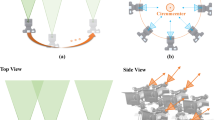Abstract
Existing commodity depth sensors have limited the field of view (FOV) of depth scanning. Our solution for extending the FOV is to use multiple depth sensors and stitch the captured depth images to a depth panorama. In our case study, we use two Kinects to address the following two questions: what is the best layout of the two Kinects to maximize the FOV and, second, how to combine the depth images together to form the depth panorama. We answer these questions by proposing a rotated top-bottom (RTB) arrangement of the two Kinects to maximize the FOV. Since the two Kinects capture the depth images from their own views, the depth values are not necessarily identical for the same object. To solve this problem, the depth adjustments are made for a frontal reference coordinate. Moreover, the perspective distortions of the two Kinects with respect to the frontal reference coordinate are corrected by perspective transformations. Experimental results show that our RTB sensor can generate panorama depth images with an almost doubled FOV.
























Similar content being viewed by others
Notes
The latest Microsoft Kinect v2 is a ToF type depth sensor, and it still suffers from the limited FOV (70° horizontally and 60° vertically).
References
Alexiadis DS, Zarpalas D, Daras P (2013) Real-Time, Full 3D Reconstruction of Moving Foreground Objects From Multiple Consumer Depth Cameras, In: IEEE Transactions on Multimedia, IEEE, 15(2), pp 339–358
Asteriadis S, ChatziToFis A, Zarpalas D, Dars P (2013) Estimating human motion from multiple Kinect Sensors. In: Proceedings of the 6th International Conference on Computer Vision/Computer Graphics Collaboration Techniques and Applications, ACM, pp 3
Benavidez P, Jamshidi M (2011) Mobile robot navigation and target tracking system. In: Proceedings of the 6th International Conference on System of Systems Engineering: SoSE in Cloud Computing, Smart Grid, and Cyber Security, SoSE 2011, pp 299–304
Brown M, Lowe D G (2007) Automatic panoramic image stitching using invariant features. In: International journal of computer vision, 74(1), pp 59–73
Burgin W, Pantofaru C, Smart WD (2011) Using depth information to improve face detection. In: Proceedings of the 6th International Conference on Human-Robot Interaction. ACM, pp 119–120
Chang YJ, Chen SF, Huang JD (2011) A kinect-based system for physical rehabilitation: a pilot study for young adults with motor disabilities. Res Dev Disabil 32(6):2566–2570
Chun S, Kang D, Choi H-R, Park A, Lee K-K, Kim J (2013) A sensor-aided self coaching model for uncocking improvement in golf swing, In: Multimedia Tools and Applications, vol. 72. pp 253–279
Gottfried JM, Fehr J, Garbe CS (2011) Computing range flow from multi-modal Kinect data. In: Proceedings of the 7th International Symposium on Visual Computing, ISVC 2011, vol. 6938. pp 758–767
Han J, Shao L, Xu D, Shotton J (2013) Enhanced Computer Vision with Microsoft Kinect Sensor: A Review, In: IEEE Transactions on Cybernetics, vol 43. IEEE, pp 1318–1334
Kim S, Uh Y, Byun H (2012) Generating panorama image by synthesizing multiple homography, In: Proceedings of the International Conference on Image Processing. ICIP 2012. IEEE, pp 2981–2984
Manap NA, Soraghan JJ (2011) Novel view synthesis based on depth map layers representation, In: Proceedings of 3DTV Conference. IEEE, pp 1–4
Rahman MA (2014) Multimedia environment toward analyzing and visualizing live kinematic data for children with Hemiplegia. Multimedia Tools and Applications. Springer, pp 1–25
Raptis M, Kirovski D, Hoppe H (2011) Real-time classification of dance gestures from skeleton animation. In: Proceedings of the 10th Annual ACM SIGGRAPH/Eurographics Symposium on Computer Animation. ACM, pp 147–156
Riche N, Mancas M, Gosselin B, Dutoit T (2011) 3D Saliency for abnormal motion selection: The role of the depth map. In: Computer Vision Systems. Springer, Berlin Heidelberg, pp 143–152
Satta R, Pala F, Fumera G, Roli F (2013) Real-time Appearance-based Person Re-identification over Multiple Kinect Cameras. In: Proceedings of International Conference on Computer Vision Theory and Applications, VISAPP 2013, pp 407–410
Schönauer C, Kaufmann H (2011) Wide Area Motion Tracking Using Consumer Hardware. In: Proceedings of Workshop on Whole Body Interaction in Games and Entertainment. ACE, pp 1–9
Stowers J, Hayes M, Bainbridge-Smith A (2011) Altitude control of a quadrotor helicopter using depth map from Microsoft Kinect sensor. In: Proceedings of the IEEE International Conference on Mechatronics, ICM 2011, IEEE, pp 358–362
Williamson BM, LaViola JJ, Roberts T, Garrity P (2012) Multi-Kinect Tracking for Dismounted Soldier Training, In: The Interservice/Industry Training, Simulation & Education Conference, I/ITSEC
Wilson AD (2010) Using a depth camera as a touch sensor. In: Proceedings of the ACM International Conference on Interactive Tabletops and Surfaces. ACM, pp 69–72
Yeo HS, Lee BG, Lim H (2013) Hand tracking and gesture recognition system for human-computer interaction using low-cost hardware. Multimedia Tools and Applications. Springer, pp 1–29
Yun S, Song W, Won CS (2013) Acquisition of Dual RGBD Images, ITC-CSCC
Zhang Z (2012) Microsoft kinect sensor and its effect. Multim IEEE 19(2):4–10
Zhang L, Sturm J, Cremers D, Lee D (2012) Real-Time Human Motion Tracking using Multiple Depth Cameras. In: Proceedings of the International Conference on Intelligent Robot Systems. IEEE, pp 2389–2395
Zug S, Penzlin F, Dietrich A, Nguyen TT, Albert S (2012) Are laser scanners replaceable by Kinect sensors in robotic applications? In: Robotic and Sensors Environments. IEEE, pp 144–149
Acknowledgments
This work was supported by Basic Science Research Program through the National Research Foundation of Korea (NRF) funded by the Ministry of Education (NRF-2013R1A1A2005024) and by the MSIP(Ministry of Science, ICT and Future Planning), Korea, under the ITRC(Information Technology Research Center) support program (IITP-2015-H8501-15-1014) supervised by the IITP(Institute for Information & communications Technology Promotion).
Author information
Authors and Affiliations
Corresponding author
Rights and permissions
About this article
Cite this article
Song, W., Yun, S., Jung, SW. et al. Rotated top-bottom dual-kinect for improved field of view. Multimed Tools Appl 75, 8569–8593 (2016). https://doi.org/10.1007/s11042-015-2772-5
Received:
Revised:
Accepted:
Published:
Issue Date:
DOI: https://doi.org/10.1007/s11042-015-2772-5




